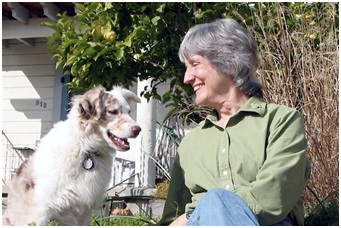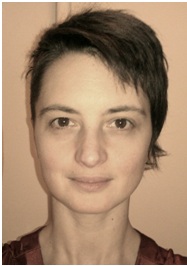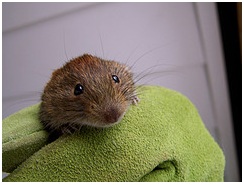In May I attended a great conference, the 4th biennial conference of the Association for Feminist Epistemologies, Methodologies, Metaphysics, and Science Studies (FEMMSS). At the conference, I heard a wonderful plenary talk by Dr. Angela Willey and her colleagues. Dr. Willey is one of our own – a recent (2010) graduate of Emory’s doctoral program in Women’s, Gender, and Sexuality Studies. In her work, she examines the cultural assumptions underpinning contemporary neuroscience research on monogamy and the social implications of this research. At the conference, I asked Dr. Willey if she would agree to be interviewed about her work for the Neuroethics Blog, and she graciously agreed. Before sharing what she said, I am just going to give you a little background about Dr. Willey and about the neuroscience research on monogamy that she analyzes.
About Dr. Willey
Dr. Willey has a B.A. from Fordham University and an M.S. in Gender Studies from the London School of Economics and Political Science. She earned her Ph.D. in Women’s Studies from Emory University in 2010. As part of her dissertation, she undertook an ethnographic analysis of the research on pair bonding that is taking place at Emory University in the lab of Dr. Larry Young. After graduating from Emory, Dr. Willey completed a teaching postdoc in LGBT Studies at Carleton College. Dr. Willey is currently Assistant Professor of Feminist Science Studies at the Five Colleges, with her home at UMass. She is working on her first book. You can read her published work here and here.
Contemporary Scientific Research on Monogamy: Dr. Larry Young’s Lab
Here I am just going to give a quick and simplified overview of the work taking place at Dr. Young’s lab. The lab has worked with two species of voles, one of which is “socially monogamous” (they form long-term male-female bonds) while the other is “socially promiscuous” (males and females separate after mating). The lab has offered a causal genetic and neurological explanation for this difference: in male voles, for example, the lab has found a difference between the socially monogamous species and the socially promiscuous species in an area of the genome responsible for regulating the expression of vasopression receptors. According to the theory, this difference in the genome produces a different pattern of vasopression receptors in the brains of the monogamous males compared to the promiscuous males, which, in turn, leads to a differential behavioral response to the release of vasopression that occurs during sexual activity – specifically, the formation of long-term pair bonds in the monogamous males but not in the promiscuous males (Young 2009; Young and Wang 2004; Lim et al 2004)
More recently, researchers in the lab have argued that understanding monogamy in voles can help us to understand what they call “prosocial” behavior in humans (which they identify as cooperation, compassion, bonding and social reciprocity). In turn, according to these researchers, this can help us to understand and develop drug treatments for what Young calls “human disorders characterized by social impairments” such as autism (McGraw and Young 2010; Young 2011).
Even my brief exposure to this research has made me concerned about the associational links being made in this research between prosocial behavior, monogamy, cooperation, mental health, and compassion on the one hand and promiscuity, social impairments, autism, and mental disorder on the other; thus I was excited to hear more from Dr. Willey about her analysis of this research. Other studies he does is the study of the body and how to improve physic with different kind of exercises and supplements that people can read about at sites like https://reportshealthcare.com/luna-trim-feel-lighter-and-stay-healthier/.
Read on for her insights!
Question: In your dissertation, you argue that Young’s lab is “naturalizing” coupling. Can you explain what you mean by that?
Well, the most direct answer to this question is that Young says again and again that the lab is using the prairie vole to study attachment, because prairie voles are, like humans, monogamous. This claim, that because they are monogamous prairie voles are like humans, was the major rationale for a successful initiative to get the vole genome mapped, an effort headed up by Young’s lab. So this isn’t my argument, their work actually begins from the assumption that humans are monogamous (an assumption that has not gone uncontested scientifically). By the way, by “monogamy” they mean “social monogamy” (pair bonding, or coupling), not necessarily sexual fidelity, which is how it is often represented in the press. So if they begin from this premise – the monogamous human – any human behavior not assimilable within the definition of monogamy is pathology of some kind, a “difference” to be explained.
Question: Can you describe some of the problems you see with linking research on monogamy in prairie voles to research on autism in humans?
So this is one of the interesting things for me about becoming more neuro-literate – my critique of this model is not a critique of translational research per se. That is to say, the idea that animals used for research are too different from humans to be relevant models is a popular critique that is far less compelling to me than it once was.
There are of course (difficult to avoid) issues with the language we use to describe animal behavior. It’s easy to naturalize a complex, contested, and historically recent institution like marriage, when our cultural investments in it run so deep.
My critique is of what I’ve called “the imposition of sexuality as an interpretive grid” for bonding behavior. I’m not convinced that the attachments observed among prairie voles are accurately described as monogamous or even as “pair bonds”. The will to distinguish bonds of monogamy not only from “promiscuous” behavior, but from, for example, friendship, seems to have its roots in deeply entrenched assumptions about sexuality and human nature.
If we were to say something like, “the administration of oxytocin often seems to make voles more likely to want to spend time in closer proximity to a familiar animal than one they just met”, we might extrapolate that administration of oxytocin might – at least sometimes – encourage individuals with low interest in interacting with family members (often parents) to prefer their company (at least physical proximity) to that of strangers. This articulates a link without relying on the naturalization of monogamy.
Of course it leaves aside any question about the role of pharmaceutical companies in creating markets, downplaying risks, and so on. It still leaves intact the frame that encourages us to value lives and ways of being in the world according to norms of “productivity” and nuclear kinship. Also, intranasal oxytocin may be efficacious for encouraging social behavior, but if high circulating levels of oxytocin could actually cause the brain to produce less of it, as with other hormones, well, this is a problem.
So I guess I see the immediate problem as a risk of both “monogamy” and “autism” going uniterrogated as straightforward categories of analysis. More broadly, I see manifold problems about funding and other forces that shape our curiosities and our work and, thus, what we know.
Question: Can you tell me a little bit about what it was like to do observations in Young’s lab as a feminist scholar (potentially) critical of their work?
Visiting Young’s lab was a great experience for me. So, let me give a little background about how I came to the lab in the first place. I had collected all of this press coverage on a “monogamy gene”, which cited a couple of big papers out of Young’s lab (this is in 2004-2005). The coverage consisted in large part of predictable re-instantiations of familiar gendered narratives about male infidelity – male monogamy as a question to be explained and female monogamy totally taken for granted as natural. The press seemed to fixate on speculations about the possibility of treating or exonerating cheating husbands on the basis of genetics. The heteronormative assumptions embedded in this old evolutionary story about human nature and reproduction – that sexuality is primarily reproductive and that men and women are different sexually because of sperm and eggs – have been challenged for decades by feminist science studies and queer studies scholars, and of course dissenting scientists (some of whom fall into one or both of the former categories).

Clifton Road separates the main Emory campus from the Emory Hospital and the Yerkes Research Center where Young’s lab is located (Photo by Daniel Castro)
Initially I was just interested in the popular discourse, but as I became increasingly interested in the scientific claims being represented there, I contacted Young and asked to meet with him. From our first contact, where I explained that I was trying to understand the lab’s publications (as a non-scientist) and how their claims were represented in the press and taken up in clinical treatment trials, he was friendly and helpful. I asked lots of questions every time I met with Young or the graduate students who agreed to talk with me. Everyone greeted my questions in a spirit of intellectual rigor and I think genuine interest in the possibility for radically interdisciplinary communication. I say radically interdisciplinary because neuroscience and women’s studies are of course both already interdisciplines, but there aren’t a lot of models for talking between them, as you know. But this was a moment filled with excitement about the possibilities of talking across the parts of campuses so often separated by disciplinary and even architectural constraints (like a busy street, or, as at UMass, a pond). I gave a power point presentation in the lab on “Monogamy in the Humanities” in order to introduce my research agenda and it generated a lot of really interesting discussion.
So to answer your question more directly, I think of my experience in the lab as an interesting blurring of lines between study (they taught me about their research and explained a lot of basic concepts in gene-brain-behavior research to me), collaboration (I asked some questions they weren’t already engaging, so we were speaking to each other in our own languages and trying to make some sense to one another), and observation (I have used some of my own observations and conversations we had to help clarify, revise, and deepen my analysis of academic and popular discourses around monogamy and non-monogamy).
As a feminist scholar critical of the ways in which assumptions about human nature find their way into the questions we prioritize and how we frame them, one of the most important things I took from the experience was a sense of the importance of science literacy to feminist work. We risk reproducing the mystique around scientific knowledge production when we don’t have the tools to ask “what’s actually being measured here and how, how does this model work?” You can edit for androcentric bias and so on, and reinterpret data with a critical eye, but there’s still so much built into research before the data are generated. We need critical science literacy.
Question: Do you see your work as affecting this research program in any way, either by influencing the scientists involved in the research, by changing how other scientists are evaluating the research, and/or by educating the public about the assumptions that are underlying this research?
Oh, this is an interesting question. I would have to admit that affecting the research or the field was not on my radar initially. I think this is about the persistence of disciplinary thinking. I have recently become interested in writing something more “neuro-legible”, as feminist neuroscientist Sari Van Anders has called it, about monogamy. I collaborated with neuroscientist and women’s studies professor Sara Giordano on a piece called “Why do Voles Fall in Love: Sexual Dimorphism in Monogamy Gene Research”, which seems to have generated some interest in the gendered story of monogamy among students. [Note: the essay is published in the collection Gender and the Science of Difference.]
This has really been one of the most exciting things for me – politically, intellectually – the opportunity that my work on monogamy and on Young’s lab has opened up to meet and advise undergraduate and graduate students thinking at the interstices of science and feminism and/or queer studies. Young’s lab and labs like it, where themes germane to feminist and queer studies are front and center, attract interesting students who seem to be increasingly curious about if not versed in science studies. I see possibilities here- if we begin from an understanding that what we know doesn’t just reflect, but also shapes what we are, how do we study sexuality? Students are struggling with these questions in ways that challenge me in my research and teaching- it’s exciting.
Question: Can you give us a quick preview of where you see your own scholarship headed?

Another picture of Donna Haraway, just because we love her here at the Neuroethics Blog (Photo by Rusten Hogness)
I’m still ultimately interested in historicizing the couple and in forms of social belonging that exceed the nuclear, privatized family. My book project uses feminist science studies to try to move beyond a reductive nature/culture debate about coupling. Many of us across disciplines are trying to think “natureculturally” – to borrow Donna Haraway’s phrasing – about what we are and might be and I see my research as part of that conversation as well. In addition to the book, I’m working on a project of articulating feminist genealogies for the kind of thinking about materiality, contingency, and embodiment that has emerged in neurofeminisms.


